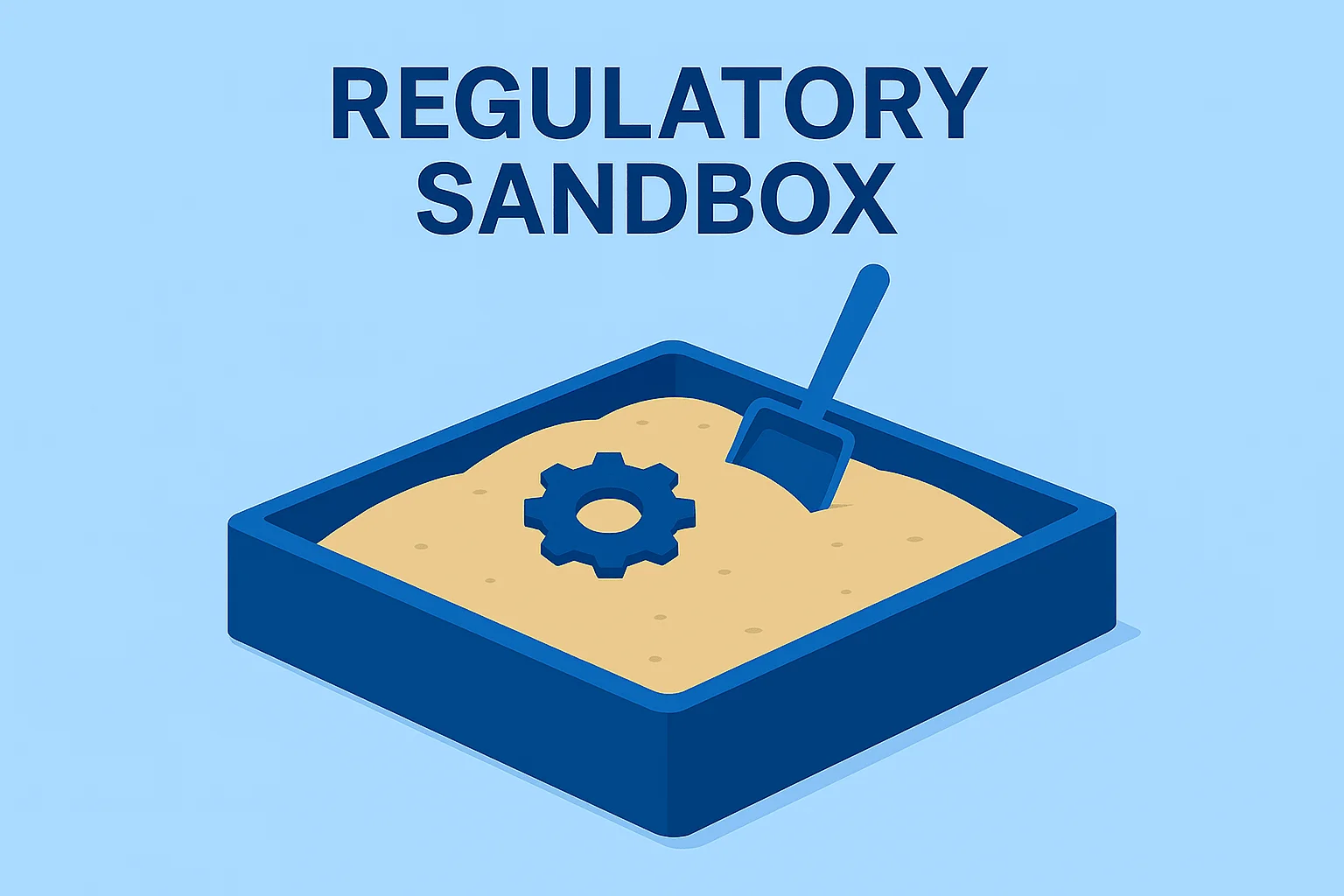What Is a Regulatory Sandbox and How Does It Benefit Fintech Companies?
- Insights & News
- June 25, 2025
The financial technology sector thrives on innovation, but there’s a catch – every new idea must pass through layers of complex regulations before reaching consumers. Promising fintech startups face a tough choice: spend months or years getting licenses and meeting regulatory requirements, or risk operating in legal gray areas.
This challenge led to the creation of regulatory sandboxes, special programs that let fintech companies test their innovations with relaxed regulatory requirements. These programs have become game-changers, offering a bridge between innovation and compliance that helps both companies and consumers.
What Is a Regulatory Sandbox?
A regulatory sandbox is basically a safe testing zone where fintech companies can try out new products and services without dealing with all the usual financial regulations. Think of it like a playground where startups can test their ideas under the watchful eye of regulators, but with fewer rules and restrictions.
What is a regulatory sandbox designed to do? These programs serve several important goals:
- Encourage innovation in financial services by removing barriers
- Help regulators understand new technologies before they go mainstream
- Protect consumers while still allowing room for experimentation
- Give smaller companies a fair shot at competing with big banks
Regulatory sandboxes also help level the playing field. Big banks have teams of lawyers and compliance experts who can handle complex rules. Smaller fintech startups usually don’t have these resources, making it tough to compete. Sandboxes give these smaller companies a chance to prove their ideas work before dealing with full regulatory requirements.2

How Regulatory Sandboxes Work
The way regulatory sandboxes operate varies between different countries and regulatory bodies, but they all share common features that make them effective testing grounds for fintech innovation.
Controlled Testing Conditions
Companies joining fintech regulatory sandbox programs work under carefully set rules. They can only test their products with a limited number of customers, usually anywhere from a few hundred to several thousand people. These testing periods are also time-limited, typically lasting six months to two years.
Companies must tell customers clearly that they’re part of a regulatory sandbox program. This honesty helps consumers understand they’re using experimental services and sets the right expectations about potential risks.
The testing scope is also limited. Companies can’t just launch whatever they want. They need to show that their innovation actually helps consumers and that they have proper safeguards to protect customer interests.
Who can participate in these programs? Most regulatory sandboxes look for companies that meet certain criteria:
- Genuine innovation that offers real benefits to consumers
- Adequate resources to conduct safe testing
- Clear testing plans with specific goals and timelines
- Proper consumer protection measures in place
- Willingness to share results and work with regulators
Regulatory Relief and Flexibility
One of the biggest draws of the regulatory sandbox for fintech companies is getting temporary relief from certain rules. This doesn’t mean companies can ignore all regulations, but specific rules that might prevent testing can be relaxed or changed.
Common regulatory breaks include:
- Licensing requirements – companies might operate without full banking licenses
- Capital requirements – less money needed in reserve accounts
- Reporting rules – simpler paperwork during testing
- Authorization processes – faster approval for new products
These breaks are carefully planned to reduce innovation barriers while keeping essential consumer protections in place. Regulators don’t just remove all oversight – they adjust requirements to fit the limited scope of sandbox activities.
Monitoring and Oversight
Even with relaxed rules, companies in regulatory sandboxes face serious monitoring and reporting requirements. They must regularly update regulators on their progress, share customer feedback, and report any problems that come up during testing.
This ongoing oversight serves several important purposes. It helps regulators understand how new technologies work in real life, spot potential problems before they become widespread, and make sure companies are protecting consumers properly.
Companies usually need to provide detailed reports about their operations, including customer complaints, security problems, financial performance, and how well they’re following sandbox rules. This transparency helps build trust between regulators and fintech companies while providing useful information for future policy decisions.

Benefits of Regulatory Sandboxes for Fintech Companies
Regulatory sandboxes offer many advantages that make them attractive options for fintech companies looking to bring new products to market.
Reduced Regulatory Burden and Faster Market Entry
The biggest benefit is dealing with less regulatory complexity during testing. Instead of spending months or years getting full licenses and meeting all requirements upfront, companies can start testing their products pretty quickly. This speed advantage is crucial in the competitive fintech world, where being first can make or break a company.
Companies also save lots of money on compliance costs during the sandbox phase. Legal fees, licensing costs, and regulatory consulting can easily cost hundreds of thousands of dollars for normal market entry. Sandbox programs cut these upfront costs dramatically.
What types of costs do companies typically save during sandbox participation?
- Legal consultation fees for regulatory compliance advice
- Licensing application costs that can run into six figures
- Compliance officer salaries for full-time regulatory staff
- Audit and assessment fees required for traditional market entry
- Documentation and filing costs for extensive regulatory paperwork
Access to Regulatory Guidance and Building Consumer Trust
Joining a regulatory sandbox gives companies direct access to regulatory experts and guidance. Instead of guessing how regulators might react to new technologies, companies can have ongoing conversations with regulatory authorities. This relationship helps companies understand what regulators expect and develop products that are more likely to get full approval after testing.
The regulatory oversight that comes with sandbox participation also helps build consumer trust. When customers know that a fintech company is working under regulatory supervision, even in a testing phase, they feel more confident about using the service. This trust factor is especially important for companies dealing with sensitive financial data or offering services with significant financial risks.
Enhanced Collaboration Opportunities
Regulatory sandboxes often create chances for collaboration between fintech companies, traditional banks, and regulatory bodies. These partnerships can help startups access resources, expertise, and customer bases that would be hard to get on their own.
Many sandbox programs actively encourage collaboration by:
- Facilitating partnerships between fintech startups and established banks
- Providing networking opportunities with other sandbox participants
- Offering mentorship programs with industry experts
- Creating forums for sharing experiences and best practices
- Connecting companies with potential investors interested in regulated fintech innovations
These collaborative aspects of sandbox programs often prove as valuable as the regulatory benefits themselves. The relationships formed during sandbox participation often continue long after the testing period ends, providing ongoing support for company growth.
Making the Most of Regulatory Sandbox Opportunities
The advantages and processes involved in participating in regulatory sandboxes make them valuable tools for fintech companies at different stages of development. Whether a company is testing a completely new idea or looking to expand an existing service into new markets, sandboxes provide structured pathways for innovation with regulatory support.
For fintech companies considering sandbox participation, the key is to approach these programs strategically. Companies should clearly define their testing goals, prepare strong consumer protection measures, and be ready to work constructively with regulatory authorities throughout the process.
Regulatory sandboxes represent more than just regulatory relief – they’re platforms for building trust and establishing market presence with official backing. Companies that successfully complete sandbox programs often find themselves better positioned for full market launch, with validated products, regulatory relationships, and consumer confidence that would be difficult to achieve through traditional approaches.




